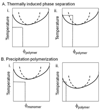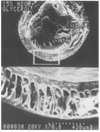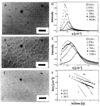Liquid-liquid two-phase systems for the production of porous hydrogels and hydrogel microspheres for biomedical applications: A tutorial review
- PMID: 20659596
- PMCID: PMC2967636
- DOI: 10.1016/j.actbio.2010.07.028
Liquid-liquid two-phase systems for the production of porous hydrogels and hydrogel microspheres for biomedical applications: A tutorial review
Abstract
Macroporous hydrogels may have direct applications in regenerative medicine as scaffolds to support tissue formation. Hydrogel microspheres may be used as drug-delivery vehicles or as building blocks to assemble modular scaffolds. A variety of techniques exist to produce macroporous hydrogels and hydrogel microspheres. A subset of these relies on liquid-liquid two-phase systems. Within this subset, vastly different types of polymerization processes are found. In this review, the history, terminology and classification of liquid-liquid two-phase polymerization and crosslinking are described. Instructive examples of hydrogel microsphere and macroporous scaffold formation by precipitation/dispersion, emulsion and suspension polymerizations are used to illustrate the nature of these processes. The role of the kinetics of phase separation in determining the morphology of scaffolds and microspheres is also delineated. Brief descriptions of miniemulsion, microemulsion polymerization and ionotropic gelation are also included.
Copyright © 2010 Acta Materialia Inc. Published by Elsevier Ltd. All rights reserved.
Figures



















Similar articles
-
Macroporous interconnected dextran scaffolds of controlled porosity for tissue-engineering applications.Biomaterials. 2005 Dec;26(35):7436-46. doi: 10.1016/j.biomaterials.2005.05.054. Biomaterials. 2005. PMID: 16023718
-
Novel glycidyl methacrylated dextran (Dex-GMA)/gelatin hydrogel scaffolds containing microspheres loaded with bone morphogenetic proteins: formulation and characteristics.J Control Release. 2007 Mar 12;118(1):65-77. doi: 10.1016/j.jconrel.2006.11.016. Epub 2006 Nov 24. J Control Release. 2007. PMID: 17250921
-
Tunable Bicontinuous Macroporous Cell Culture Scaffolds via Kinetically Controlled Phase Separation.Adv Mater. 2025 Feb;37(7):e2410452. doi: 10.1002/adma.202410452. Epub 2025 Jan 2. Adv Mater. 2025. PMID: 39745118 Free PMC article.
-
Biocompatibility of hydrogel-based scaffolds for tissue engineering applications.Biotechnol Adv. 2017 Sep;35(5):530-544. doi: 10.1016/j.biotechadv.2017.05.006. Epub 2017 May 27. Biotechnol Adv. 2017. PMID: 28558979 Review.
-
A Review of Injectable Polymeric Hydrogel Systems for Application in Bone Tissue Engineering.Molecules. 2016 Nov 21;21(11):1580. doi: 10.3390/molecules21111580. Molecules. 2016. PMID: 27879635 Free PMC article. Review.
Cited by
-
Changes of chondrocyte expression profiles in human MSC aggregates in the presence of PEG microspheres and TGF-β3.Biomaterials. 2011 Nov;32(33):8436-45. doi: 10.1016/j.biomaterials.2011.07.056. Epub 2011 Aug 4. Biomaterials. 2011. PMID: 21820171 Free PMC article.
-
From Nanofibrous Hollow Microspheres to Nanofibrous Hollow Discs and Nanofibrous Shells.Macromol Rapid Commun. 2015 Oct;36(19):1735-41. doi: 10.1002/marc.201500342. Epub 2015 Aug 6. Macromol Rapid Commun. 2015. PMID: 26247175 Free PMC article.
-
Thermosensitive behavior in cell culture media and cytocompatibility of a novel copolymer: poly(N-isopropylacrylamide-co-butylacrylate).J Mater Sci Mater Med. 2013 Apr;24(4):1043-52. doi: 10.1007/s10856-013-4861-1. Epub 2013 Jan 30. J Mater Sci Mater Med. 2013. PMID: 23361967
-
Cellulose-based hydrogel materials: chemistry, properties and their prospective applications.Prog Biomater. 2018 Sep;7(3):153-174. doi: 10.1007/s40204-018-0095-0. Epub 2018 Sep 4. Prog Biomater. 2018. PMID: 30182344 Free PMC article. Review.
-
Modular poly(ethylene glycol) scaffolds provide the ability to decouple the effects of stiffness and protein concentration on PC12 cells.Acta Biomater. 2011 Nov;7(11):3841-9. doi: 10.1016/j.actbio.2011.06.054. Epub 2011 Jul 13. Acta Biomater. 2011. PMID: 21787889 Free PMC article.
References
-
- Chung HJ, Park TG. Surface engineered and drug releasing pre-fabricated scaffolds for tissue engineering. Advanced Drug Delivery Reviews. 2007;59:249–262. - PubMed
-
- Karageorgiou V, Kaplan D. Porosity of 3D biomaterial scaffolds and osteogenesis. Biomaterials. 2005;26:5474–5491. - PubMed
-
- Mikos AG, Temenoff JS. Formation of highly porous biodegradable scaffolds for tissue engineering. EJB Electronic Journal of Biotechnology. 2000;3:114–119.
-
- Rivest C, Morrison DWG, Ni B, Rubin J, Yadav V, Mahdavi A, et al. Microscale hydrogels for medicine and biology: Synthesis, characteristics and applications. Journal of Mechanics of Materials and Structures. 2007;2:1103–1119.
-
- Khademhosseini A, Langer R. Microengineered hydrogels for tissue engineering. Biomaterials. 2007;28:5087–5092. - PubMed
Publication types
MeSH terms
Substances
Grants and funding
LinkOut - more resources
Full Text Sources
Other Literature Sources

